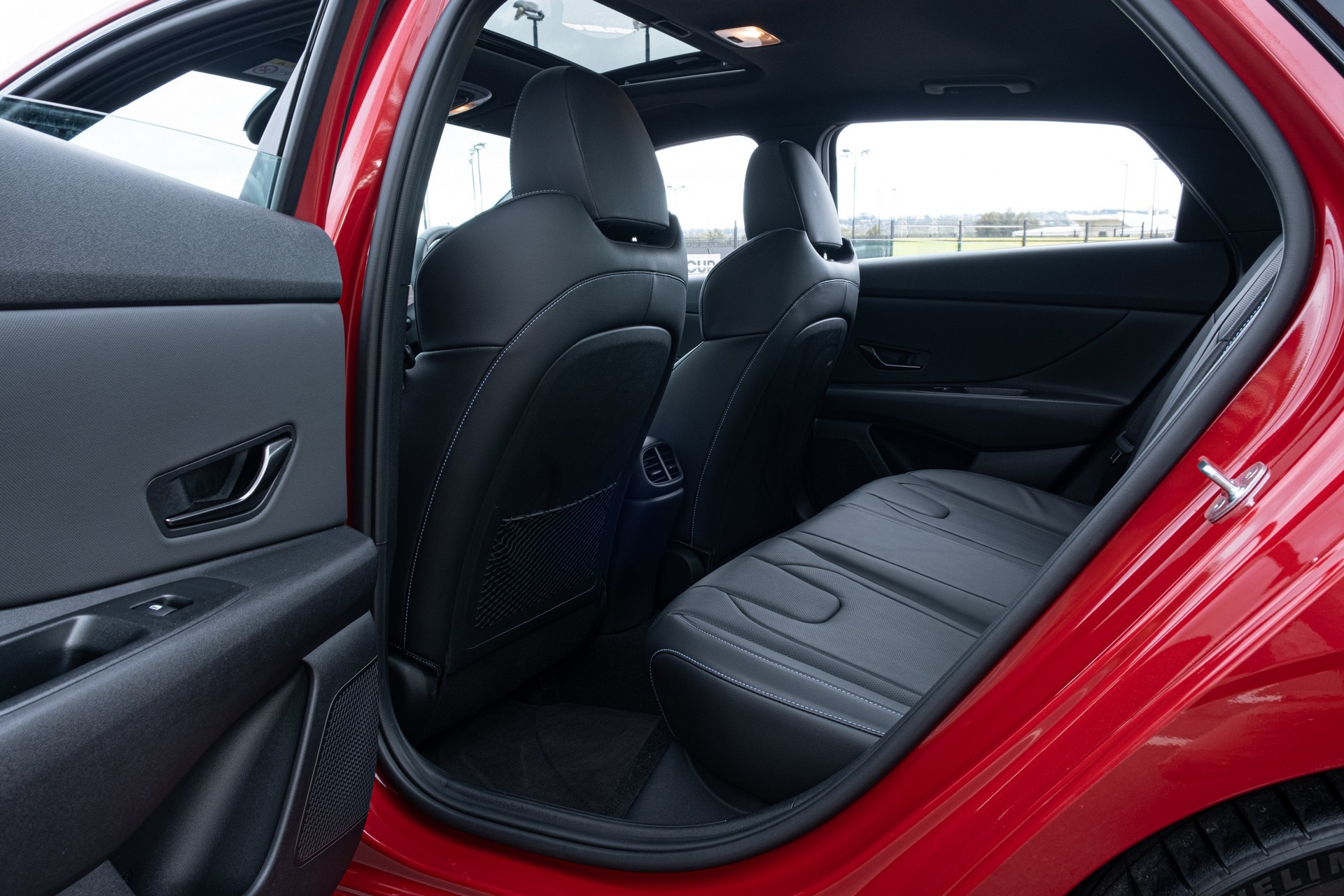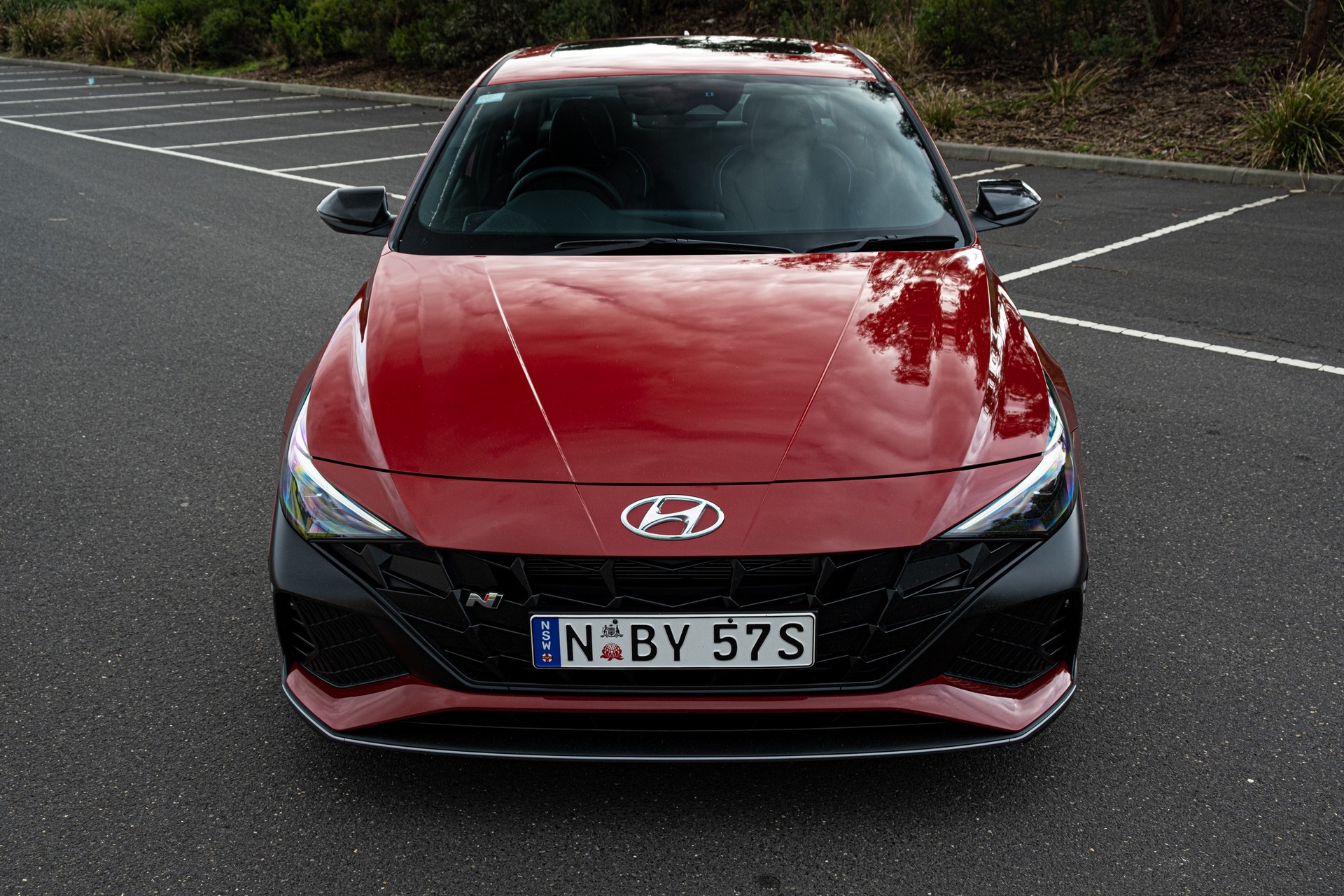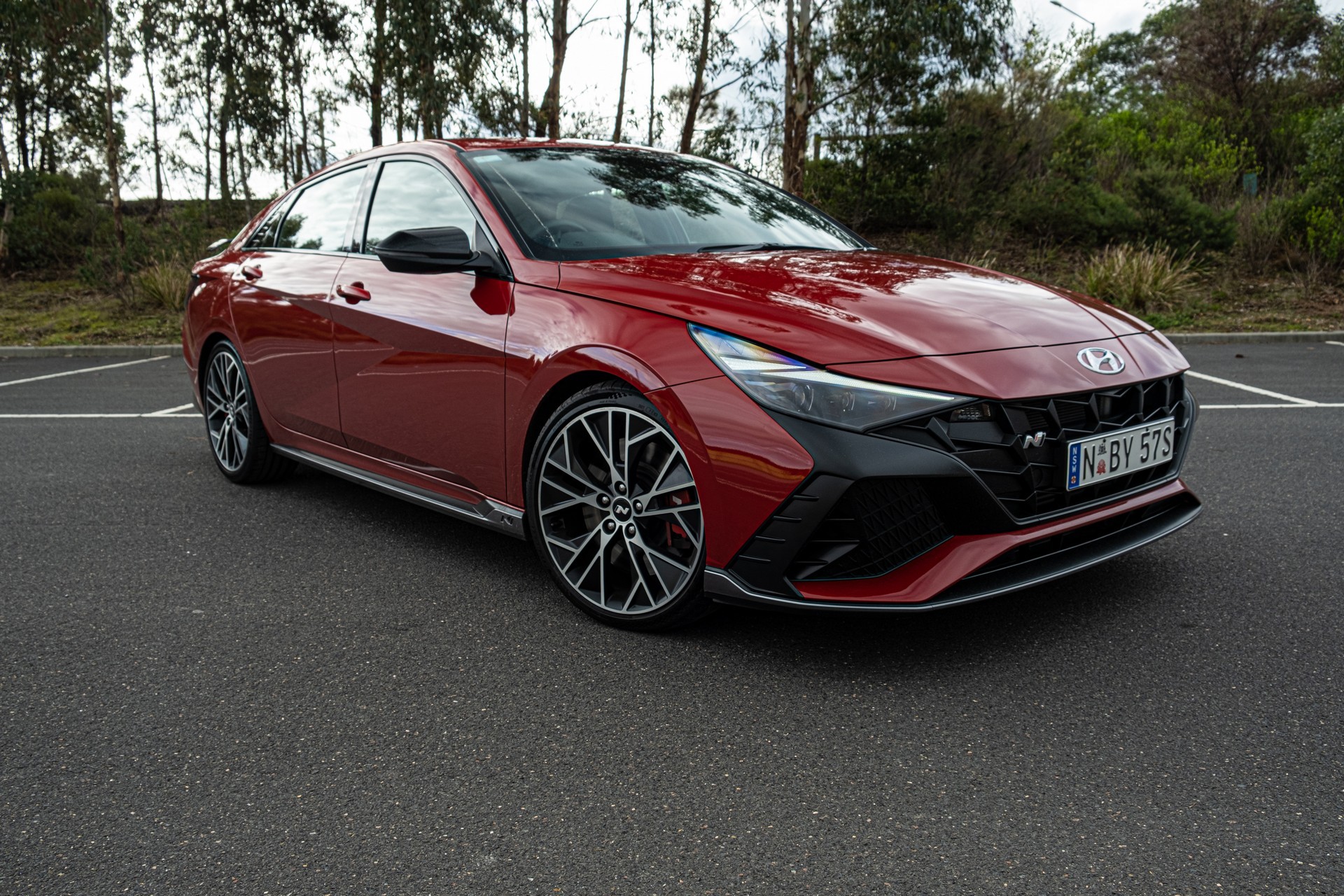Can a sports sedan be front-wheel drive? Many car enthusiasts probably don’t think so, noting that a proper sporty sedan should be rear-wheel drive or at the very least, all-wheel drive. Let those detractors drive the new Hyundai i30 Sedan N, however, and we suspect most will agree that it should be viewed as one of the best sports sedans on the market.
It has been roughly 12 months since the car was first unveiled and in most markets outside of Korea, it is known as the Elantra N. In Australia, it is badged as the i30 Sedan N but that’s purely for marketing and under the skin, it is just like the Elantra N sold overseas. We recently spent a week with one and were left very impressed.
An exceptional base
Found beneath the skin of the i30 Sedan N is the automaker’s K3 platform. This makes it the first N model to use this platform and also provides it with a longer wheelbase than the i30 N hatch. It is 4,675 mm (184 inches) long, 1,825 mm (71.8 inches) wide, and 1,425 mm (56 inches) tall while the wheelbase sits at 2,720 mm (107 inches).
Powering the sedan is Hyundai’s familiar 2.0-liter T-GDi turbocharged four-cylinder with 206 kW (276 hp) between 5,500 and 6,000 rpm and 392 Nm (289 lb-ft) of torque from 2,100 to 4,700 rpm. This engine has a 9.5:1 compression ratio and is the same unit as found in the i30 N hatch.
Two transmissions are offered to customers. The first, as featured in our press car, is a six-speed manual while the second is an eight-speed wet dual-clutch. Both drive the front wheels through an electronically-controlled mechanical limited-slip differential. Again, just like the hatchback.
There are some important mechanical components that distinguish the i30 Sedan N from the hatch. The most significant is the inclusion of Hyundai’s new Integrated Drive Axle (IDA) that combines the wheel hub, driveshaft, and wheel bearing into a single unit. This setup reduces unsprung mass by 1.7 kg (3.7 lbs) per corner, allows for the fitment of a 59 per cent larger diameter wheel bearing, and is 55 per cent more rigid than other N models.
Hyundai has also equipped the i30 Sedan N with a unique set of 19-inch alloy wheels that are stiffer than those found on other N models and are wrapped in a bespoke version of Michelin’s Pilot Sport 4S tires, measuring 245 mm wide at all four corners.
The best Hyundai interior at this price point
All i30 Sedan N models sold in Australia come in ‘Premium’ guise and have an interior loaded with nice features. The obvious highlight of the cabin is the 10.25-inch digital instrument cluster and the 10.25-inch infotainment screen. Housed within this screen are all the customization options for the various different driving modes. Wired Apple CarPlay and Android Auto is also supported.
As mentioned, the driving position is excellent and far superior to the hatch. We were particularly fond of the round steering wheel that doesn’t follow so many other performance cars in adopting a flat-bottom design. Models equipped with the six-speed manual have a bright red button on the wheel to enable or disable the Rev Matching function while those with the dual-clutch have a red button for the N Grin Shift (NGS) mode.
One thing that the i30 Sedan N misses out on when compared to the facelifted hatch is the availability of the N Sport seats. These seats, which are available in the U.S., are slimmer and more aggressive than the standard ones and would be a welcome inclusion on the Sedan. As it is, the standard seats are good and offer enough bolstering for all but the most aggressive of driving. They are also very comfortable.
The second row is surprisingly spacious but it is the boot that is the real pièce de résistance of the i30 Sedan N’s appeal. With the rear seats folded up, the car can support 464 liters (16.3 cubic-feet) of luggage and storage space only grows further when the seats are folded down (Hyundai doesn’t quote a figure), although admittedly, the rear strut brace does eat up some room. To put the boot space into perspective, the i30 N hatch can swallow up 381 liters (13.4 cubic-feet).
All i30 Sedan Ns sold in Australia come standard with the Hyundai SmartSense package. That brings with it Blind Spot Collision Avoidance Assist, Driver Attention Warning, Forward Collision-Avoidance with City/Urban/Pedestrian functionality, High Beam Assist, Lane Following Assist, Lane Keeping Assist, Lead Vehicle Departure Alert, Rear Cross-Traffic Collision-Avoidance Assist, Rear Occupant Alert, and Safe Exit Warning. One thing it does miss out on is radar cruise control.
Enough with the specs, how about the drive?
I’ve had the chance to drive all of Hyundai’s N models over the past three years and each and every one of them is great. From the pint-sized i20 N with its buzzy engine and tenacious grip through to the high-riding Kona N with its comfort and poise, Hyundai’s N division has been on a roll since 2018. The i30 Sedan N takes things to a new level.
Slide into the driver’s seat for the first time and you are welcomed by an interior far superior to any other N model. The cabin is largely identical to the ‘regular’ i30 Sedan models and importantly, allows you to sit much lower than you do in the i30 N hatch. With the seat set to the perfect position and the steering wheel positioned close and high, we set off. Or tried to, at least.
Driven: 2021 Hyundai i30 N DCT Is Even Better Than The Six-Speed
As mentioned, the press car we tested was equipped with the standard six-speed manual. I was initially surprised by the lightness of the clutch and stalled the car right away. Not only is the clutch light but it can be a little tricky to feel the engagement point. Nevertheless, after one more attempt, I drove off.
Immediately, I entered into the N customization mode and turned everything up to its highest setting, albeit for the steering which is best left in Normal mode. The first thing that impressed me was the ride quality.
The i30 Sedan N is equipped with the Electronically Controlled Suspension and models sold in Australia benefit from a local suspension tune in the Normal and Sport settings. In the original i30 N hatchback, Normal was pretty much the only suitable option for everyday driving as Sport was too firm and Sport+ would leave you with a tweaked back and in desperate need of a massage. Not so with the Sedan.
The firmest Sport+ suspension setting in the car is absolutely suitable for everyday driving duties. The elongated wheelbase, revised geometry, and other trickery results in a far more comfortable and composed ride than any other N model. Regardless of how poor the road surface may be, the i30 Sedan N feels at home.
Grip for days
The improved ride, ferocious electronically-controlled mechanical limited-slip differential, and the aforementioned Michelin Pilot Sport 4S tires also mean this is easily the best-handling N model. In fact, it has better handling than any performance car in the segment, including the outgoing FK8-generation Honda Civic Type R, considered by many as the hot hatch king since its launch.
Turn-in feels instantaneous and regardless of whether the road is bone dry or a little slippery, the car feels like it has endless amounts of grip. Try as we might, we never experienced even the slightest hint of understeer nor were we able to get the tires to screech just a little bit. The i30 Sedan N turns so well that you can easily take tight corners at half or even three-quarter throttle, allowing the e-LSD to do its job and pull you into the apex. For a vehicle at this price point, it beggars belief.
The engine is just as strong as it is in other N models. For the most part, the 2.0-liter mill is the same as the hatch, although Hyundai’s engineers have equipped it with a new high-flow air intake that’s slightly larger than found in other models. Power and torque is excellent, although you do have to keep the engine above 3,000 rpm to feel a noticeable kick. Drivers that do so will be rewarded with a powertrain that roars all the way to the redline. Hyundai claims it’ll sip just 8.2 l/100 km (28.6 mpg) over the combined cycle but we averaged 12.6 l/100 km (18.6 mpg). On the highway, it’s easy to get fuel consumption to drop to as low as 6.4 l/100 km (36.7 mpg).
A Launch Control system is featured on both the six-speed manual and DCT models. This system can be a little finicky to enable and even when it is engaged, it’s not particularly effective with the six-speed. You see, while Hyundai says the car needs just 5.5 seconds to hit 62 mph (100 km/h) with the manual and 5.3 seconds with the DCT, it’s very difficult to launch it without experiencing a heap of wheelhop at the top of first gear. The only way around it is to either feather the throttle or keep the ESC system in its Normal mode, allowing it to work out how to best put the power to the ground. Pin the throttle through first gear in the Sport or ESC Off settings and the wheelhop can get quite violent.
And the gearbox? It is great, albeit not as excellent as the six-speed of the Civic Type R, though few are. It did take a couple of hours to get used to the clutch and in order to pull away quickly and smoothly, you have to feel as though you are slightly riding the clutch. Learning curve aside, we have nothing but positive things to say about the transmission.
The shift knob is nicely weighted and the short throws between the gears make shifting very pleasurable, as does the notchy feel of the system.
The brakes are also superb, as they are in all N models. Rather than sourcing brakes from a third party like Brembo, Hyundai developed them in-house and regardless of how hard you push, they never seem to fade. The Sedan also benefits from a Brake Prefill function that primes the braking pressure as you ease off the throttle.
The competition need to play catch up
Hyundai has priced its new performance weapon very competitively, starting at AU$49,000 ($33,832) before any on-road costs and regardless of whether you go with the six-speed or the DCT. This makes it AU$4,000 ($2,761) more expensive than an equivalent i30 N hatch and AU$1,000 ($690) more than the Kona N. It also undercuts the likes of the Toyota GR Yaris, Honda Civic Type R, Renault Megane R.S., and VW Golf R, even though these are hatches rather than sedans. Perhaps its closest rival is the 2023 Subaru WRX, starting from $44,990 ($31,063).
So, just how good is the i30 Sedan N? Well, not only is it the best performance sedan at this price point but it is also one of the best performance cars under AU$100,000 ($69,000), combining thrilling performance with everyday practicality, comfort, and versatility. That’s how good it is.










ivermectin 12mg online – buy carbamazepine generic cost carbamazepine 200mg
order absorica for sale – where to buy decadron without a prescription buy linezolid 600 mg pills
buy generic zithromax – order tinidazole 300mg online cheap buy bystolic no prescription
order prednisolone 20mg sale – buy generic azithromycin prometrium 100mg sale
gabapentin for sale online – anafranil medication sporanox tablet
where can i buy clavulanate – buy nizoral 200mg pills cymbalta online buy
purchase acticlate generic – glucotrol us glipizide online buy
buy augmentin cheap – order ketoconazole 200 mg without prescription order cymbalta 20mg online
buy semaglutide cheap – buy vardenafil sale buy cyproheptadine 4mg without prescription
order tadalafil – sildenafil uk viagra 100mg cheap
sildenafil sale – viagra 50mg pills for men cialis pills
cenforce 100mg pills – order glycomet 1000mg generic glucophage 500mg sale
cost lipitor – buy zestril 5mg generic buy zestril generic
order atorvastatin 40mg online cheap – atorvastatin 20mg over the counter zestril 2.5mg for sale
omeprazole price – order prilosec 20mg generic order tenormin pill
oral methylprednisolone – methylprednisolone 8 mg pills aristocort cost
buy desloratadine without prescription – dapoxetine 30mg tablet dapoxetine 90mg uk
misoprostol 200mcg for sale – order orlistat without prescription diltiazem online buy
order zovirax generic – zyloprim uk rosuvastatin 10mg for sale
buy motilium 10mg – sumycin for sale online flexeril tablet
buy generic motilium online – order domperidone 10mg online buy flexeril online cheap
propranolol without prescription – inderal 10mg tablet order methotrexate for sale
where can i buy warfarin – buy cheap warfarin order losartan 50mg for sale
levaquin usa – buy levaquin buy ranitidine 150mg generic
nexium where to buy – order topiramate generic buy imitrex pill
mobic 7.5mg over the counter – mobic price order tamsulosin 0.4mg pills